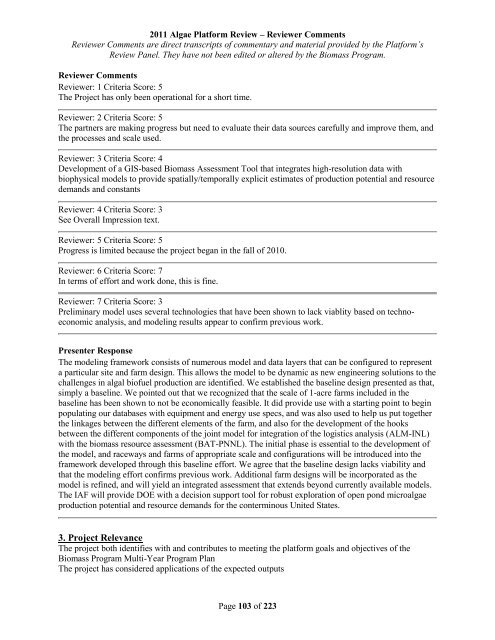Reviewer Comments - EERE
Reviewer Comments - EERE
Reviewer Comments - EERE
Create successful ePaper yourself
Turn your PDF publications into a flip-book with our unique Google optimized e-Paper software.
2011 Algae Platform Review – <strong>Reviewer</strong> <strong>Comments</strong><br />
<strong>Reviewer</strong> <strong>Comments</strong> are direct transcripts of commentary and material provided by the Platform’s<br />
Review Panel. They have not been edited or altered by the Biomass Program.<br />
<strong>Reviewer</strong> <strong>Comments</strong><br />
<strong>Reviewer</strong>: 1 Criteria Score: 5<br />
The Project has only been operational for a short time.<br />
<strong>Reviewer</strong>: 2 Criteria Score: 5<br />
The partners are making progress but need to evaluate their data sources carefully and improve them, and<br />
the processes and scale used.<br />
<strong>Reviewer</strong>: 3 Criteria Score: 4<br />
Development of a GIS-based Biomass Assessment Tool that integrates high-resolution data with<br />
biophysical models to provide spatially/temporally explicit estimates of production potential and resource<br />
demands and constants<br />
<strong>Reviewer</strong>: 4 Criteria Score: 3<br />
See Overall Impression text.<br />
<strong>Reviewer</strong>: 5 Criteria Score: 5<br />
Progress is limited because the project began in the fall of 2010.<br />
<strong>Reviewer</strong>: 6 Criteria Score: 7<br />
In terms of effort and work done, this is fine.<br />
<strong>Reviewer</strong>: 7 Criteria Score: 3<br />
Preliminary model uses several technologies that have been shown to lack viablity based on technoeconomic<br />
analysis, and modeling results appear to confirm previous work.<br />
Presenter Response<br />
The modeling framework consists of numerous model and data layers that can be configured to represent<br />
a particular site and farm design. This allows the model to be dynamic as new engineering solutions to the<br />
challenges in algal biofuel production are identified. We established the baseline design presented as that,<br />
simply a baseline. We pointed out that we recognized that the scale of 1-acre farms included in the<br />
baseline has been shown to not be economically feasible. It did provide use with a starting point to begin<br />
populating our databases with equipment and energy use specs, and was also used to help us put together<br />
the linkages between the different elements of the farm, and also for the development of the hooks<br />
between the different components of the joint model for integration of the logistics analysis (ALM-INL)<br />
with the biomass resource assessment (BAT-PNNL). The initial phase is essential to the development of<br />
the model, and raceways and farms of appropriate scale and configurations will be introduced into the<br />
framework developed through this baseline effort. We agree that the baseline design lacks viability and<br />
that the modeling effort confirms previous work. Additional farm designs will be incorporated as the<br />
model is refined, and will yield an integrated assessment that extends beyond currently available models.<br />
The IAF will provide DOE with a decision support tool for robust exploration of open pond microalgae<br />
production potential and resource demands for the conterminous United States.<br />
3. Project Relevance<br />
The project both identifies with and contributes to meeting the platform goals and objectives of the<br />
Biomass Program Multi-Year Program Plan<br />
The project has considered applications of the expected outputs<br />
Page 103 of 223




